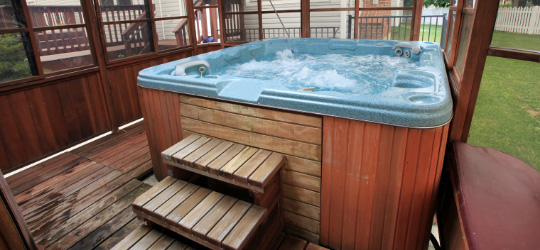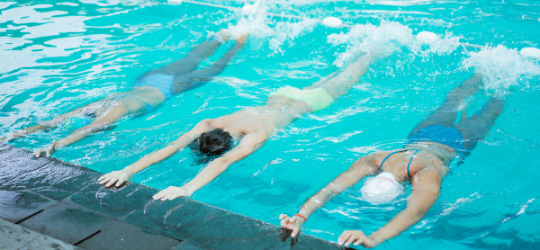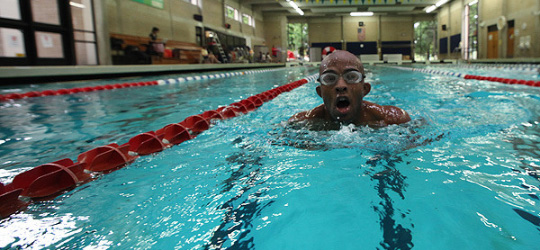Hydrotherapy is probably the most widely used treatment for ailments in human history. It’s been written about since pre-biblical times. The father of modern medicine, Hippocrates, prescribed soaking in spring water for all types of illness.

Given that more than 99% of the molecules that make up our body are water, it’s not surprising that it can have healing properties. In today’s world, there are almost endless types of water-based therapies available, but the two we’ll cover in this lesson are:
- Warm/hot water soaking
- Aquatic exercise
These tend to be the most easily accessible, have measurable benefits, and can be directly connected to recovery.
Warm/hot water soaking

Soaking a heated pool of water is probably the single oldest therapy there is. All it takes is a few minutes of immersion to start to feel better. Common benefits associated with soaking in water include:
- Reduced pain
- Better movement
- Increased immunity
- Lower blood pressure
- Mental relaxation
Not surprisingly, these are many of the same benefits reported from exercise. The simple reason for that is that working out and soaking in a warm or hot tub are both linked to increased blood flow throughout the body.
If you measure your heart rate in a hot tub, you may be surprised to learn that it can go all the way up to 100bpm or more—the same as a moderate speed walk for many people.
This is because when you’re submerged in warm water, blood pressure decreases and makes it much easier for your heart to pump blood and oxygen. At the same time, water immersion reduces some of the effects of gravity and allows for general muscle relaxation.
The end result is that you get many of the same effects and benefits of exercise by increasing circulation, without putting stress on your muscles and supporting tissues.
When you get out of the water, your body shifts more towards a parasympathetic recovery state as it reduces core body temperature and lowers heart rate.
This is why you often feel so relaxed and sleep better.
The key to using hot water therapy to promote recovery effectively is getting the dose right. Using a temperature that’s too high or spending too much time in the water can have the opposite effects.
The temperature range most well-supported in the research is 100-104° F (38-40° C), which is close to our natural human body temperature. Going significantly cooler than that may reduce some of the benefits, and going much hotter can cause too much of an increase in core body temperature.
A general guideline to shoot for is to soak for between 10-30 minutes, depending on the temperature of the water. The rule of thumb is the hotter the water, the fewer minutes you should soak in it.
A particularly good time to soak is around 90 minutes before you plan to go to bed. There’s research that this can speed up how quickly you are able to fall asleep, while also supporting better sleep quality as well.
Aquatic exercise

While soaking in warm/hot water can provide a range of health benefits, exercising in water has even more potential to speed up recovery. It’s not just for the elderly or the injured.
More and more athletes and teams are turning to training in the water to build fitness, enhance recovery, and stay healthy.
That’s because training in the water can supercharge blood flow even higher than soaking, with research showing circulation to deep tissues can be up to 200% greater when submerged up to the neck.
This is due to the movement and the pressure changes that come from being surrounded in a larger pool of water.
Given how easy it is to move underwater, you can perform almost an infinite number of exercises and movement patterns.
A particularly effective way to use the pool to promote recovery is to focus on muscles that were worked at higher intensities the previous day.
Getting in the pool and doing 3-4 sets of 8-10 jump squats or lunges in the water a day after a hard lower body workout can have a huge impact on soreness and recovery.
This type of training is also perfect for incorporating the recovery workouts we’ve talked about.
A simple, but highly effective, pool workout to help drive recovery is one I used for years with some of the world’s best combat athletes:
- 5 min of deep water treading to warm up
- 5 min of shallow water mobility exercises
- 4-6 sets of 8-10 reps of jump squats/lunges or other exercises
- 5-10 min lap swim
- 5 min of deep water floating for cool down

The advantage to this type of training is that it doesn’t take much time, won’t add any stress on your joints or soft tissues, and it drives a ton of blood flow throughout every tissue in the body.
Even a single pool workout per week can make a noticeable difference in your ability to recover from your higher intensity sessions and the stress of life.
Taken together, soaking in warm/hot water and training in the water have been used for centuries for a reason. They can effectively boost your recovery while supporting all-around health, wellness, and even longevity.
Action step
Try taking a hot bath 7 nights in a row around 90 minutes before bedtime. Look at your total sleep time and average HRV across the week and see if you notice a difference in your recovery.
If you have access to a pool, try to fit in at least one recovery workout in the water this week.
